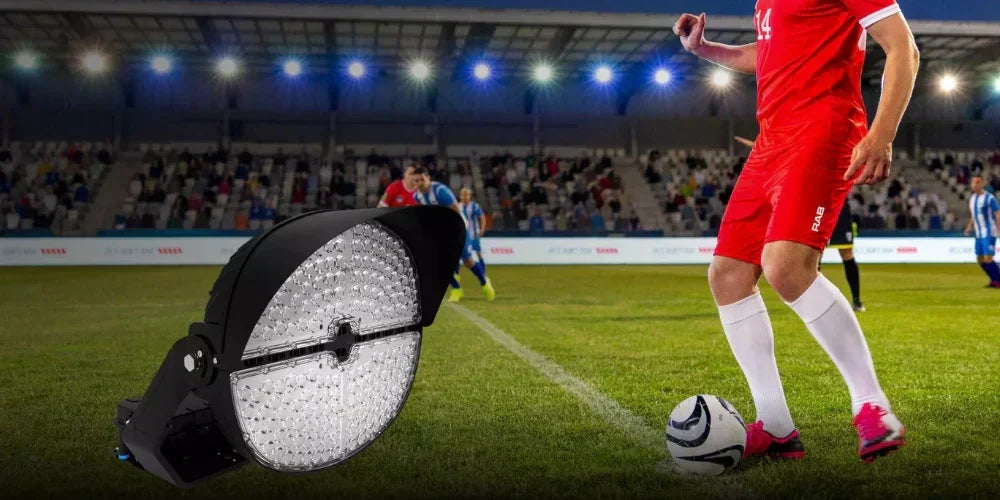Picture a classic night game: the roar of the crowd, the thrill of the action, and the towering lights illuminating the field. For decades, that light came from massive, energy-hungry metal halide fixtures that hummed loudly, took forever to warm up, and cast a harsh, uneven glare. Today, the game has changed. Modern stadiums are making the switch to high-performance LED lighting, a move that massively boosts energy efficiency, cuts costs, and dramatically improves the experience for players and fans alike.
At Bees Lighting, we're at the forefront of this evolution, providing advanced LED stadium and sports lighting solutions that deliver powerful performance while keeping energy consumption in check.

Why Modern LEDs are a Game-Changer for Stadiums
The switch from traditional lighting to LED is less of an upgrade and more of a complete technological leap forward. The benefits go far beyond just a better-looking game.
Massive Energy Savings
LEDs consume up to 70-80% less energy than their predecessors. This translates directly to lower electricity bills and reduced operational costs. The efficiency of an LED system is also scalable to your specific needs. For instance, a recreational Class IV football field might only require 20 footcandles of light, a goal that can be met with a total of about 17,000 watts. However, a competitive Class II field for thousands of spectators needs 50 footcandles, requiring a more powerful system using nearly 34,000 watts. Modern LED systems allow for this precise tuning, ensuring you're not overspending on energy for a level of play that doesn't require it.
Unmatched Longevity and Reliability
One of the biggest operational headaches with old stadium lighting was the constant, costly maintenance. Changing bulbs on 70-foot poles is no simple task. High-quality LED fixtures are engineered for extreme longevity. Fixtures like the RAB P1 series are rated with an L70 lifespan of over 100,000 hours, meaning they will maintain at least 70% of their initial brightness for well over a decade. This reliability drastically cuts down on maintenance costs and labor.
Superior Light Quality and Performance
LEDs provide bright, crisp, uniform light that eliminates shadows and dark spots. Professional lighting designs use metrics like the 'Max/Min' ratio to guarantee this even coverage. Achieving excellent uniformity creates a safer, more consistent playing surface for athletes and a far better viewing experience for fans, whether they're in the stands or watching a broadcast at home.
It's All in the Design: A Look at a Real-World Layout
Achieving peak performance and efficiency isn't just about the fixture; it's about the design. A photometric layout is a professional lighting simulation that acts as the blueprint for a project. It shows exactly how the lights will perform in a specific venue, guaranteeing the results before a single fixture is installed.
Anatomy of a Football Field Layout
Let's break down a real-world example for a competitive football field.
Classification of Play: This design targets Class II, which is suitable for competitive high school or college games with up to 5,000 spectators. The IES (Illuminating Engineering Society) recommends an average of 50 footcandles (fc) on the field for this level of play.

Fixture Selection: The design strategically uses a combination of 56 RAB P1 fixtures mounted on four 70-foot poles. These fixtures are chosen with different NEMA beam spreads to precisely aim the light from the poles to the field, maximizing coverage and minimizing glare.

The Results: The calculation summary confirms the design is a success, achieving an average of 53.17 fc across the playing surface—perfectly meeting the IES standard. This data-driven approach ensures the lighting will be flawless on opening night.
Choosing the Right LED Stadium Lights for Your Venue
When you're ready to upgrade, a few key technical specifications make all the difference.
- Beam Angle (NEMA Distribution): Not all light beams are the same. As seen in professional layouts for baseball and football, different fixture models are used for their specific NEMA beam patterns. A narrow NEMA 2Hx2V is great for throwing light a long distance, while a wider NEMA 4Hx4V provides broader coverage up close. Fixture families like the Sylvania LED Sports Lights or RAB P1 offer multiple beam patterns, allowing a designer to "paint" the field with light with pinpoint accuracy. This prevents wasted energy from light spilling into the sky or the stands.
- Controls and Dimming for Deeper Savings: For even more efficiency, look for fixtures with modern control options. The RAB P1 series, for example, comes standard with 0-10V dimming. This allows the facility to easily reduce light levels—and energy use—during practice sessions or other events that don't require full, game-day brightness.
- Mounting and Durability: Professional layouts specify crucial details like pole height, mounting location, and the precise tilt angle of each fixture. It's why choosing durable, outdoor-rated fixtures from trusted brands like Keystone and GLT is essential. They are built to withstand the elements and hold their position for years of reliable service.
A Greener Choice for the Community
The benefits of energy-efficient lighting extend beyond the stadium walls. By reducing energy consumption, LED lighting lowers a venue's carbon footprint. And because the light is directed so precisely onto the field, it significantly reduces light pollution in the surrounding community, making for darker skies and happier neighbors.
The Future of Stadium Lighting is Bright and Efficient
Upgrading to LED stadium lighting is a winning decision for any school, municipality, or sports club. It lowers energy costs, reduces maintenance, improves safety for players, and creates a world-class experience for fans. The key is to pair high-performance products with expert design.
Ready to bring your facility into the modern era? Browse the complete collection of LED stadium and sports lights at Bees Lighting, or contact our team of lighting experts today for a complimentary consultation on your project.





